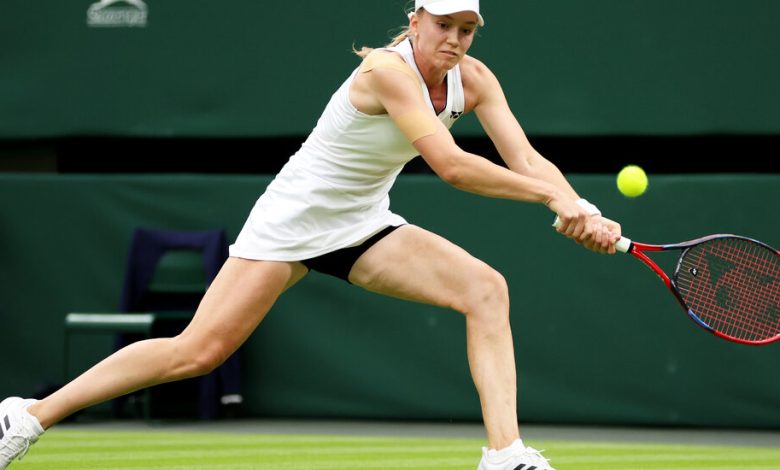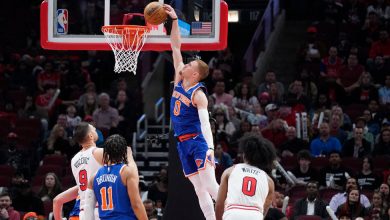At Wimbledon, Everyone’s Chasing Swiatek, Sabalenka and Rybakina

LONDON — Elena Rybakina was nervous. She was embroiled in her first match on Wimbledon’s Centre Court as defending champion. She was facing a tough opponent in Shelby Rogers. The roof was closed and she was recovering from a virus.
Even more daunting, one of the greatest players ever to walk that court, Roger Federer, was now sitting just a few feet behind her, in the royal box, watching her struggle.
“Yeah, maybe that’s why I was nervous,” Rybakina said after she recovered to beat Rogers on Tuesday, 4-6, 6-1, 6-2.
Federer, now retired, was back at Wimbledon for a visit. As a player, he was a member of the so-called Big Three of men’s tennis, along with Rafael Nadal and Novak Djokovic. As a spectator, he was watching a player whom some experts, including Chris Evert, believe is part of an emerging big three of women’s tennis.
Rybakina, the third-ranked player in the world, along with No. 1 Iga Swiatek and No. 2 Aryna Sabalenka, comprise the top of the women’s tennis pyramid. Together, they have won the last five major tournaments, and the eventual winner of this year’s Wimbledon is expected — but obviously not guaranteed — to come from their elite group, as well.
Those who think it is premature to crown a triumvirate of women’s tennis will find the 24-year-old Rybakina in agreement.
“I think it’s too early to say anything about just three players because it’s not like it was Roger or Djokovic,” Rybakina said. “It’s still too far.”
All three players are under 26, and all have the necessary tools to win multiple tournaments and remain at the top of the rankings. Left out of the grouping are players like Jessica Pegula, ranked No. 4. But Pegula said she agrees that the top three are the class of the women’s game and deserve the recognition, even if she would like to expand the number to four someday.
“I think it’s exciting to have something for us to talk about and for fans to get involved in and hopefully be excited to watch them battle it out,” Pegula said on Saturday. She beat Lauren Davis in the first round on Monday. “But I hope I’m part of that conversation at some point. I guess that’s all I have to say.”
Ons Jabeur, who lost to Rybakina in last year’s Wimbledon final and to Swiatek in the U.S. Open final, is a solid grass court player, who could also stake a claim to this year’s Wimbledon title. Jabeur is another who believes that Swiatek, Sabalenka and Rybakina have set themselves apart.
“For me it’s inspiring to see them doing great,” Jabeur said. “You can learn a lot from them.”
Coco Gauff, who is only 19 and ranked No. 7, could also intrude into the mix one day. But not yet, not after she lost to Sofia Kenin, a former No. 4 player who is 24, in the first round on Monday.
As Rybakina said on Tuesday, “anyone can still beat anyone.”
As Wimbledon opened under rainy skies, each one of the three top players had at least one question to answer on court before she could lift the trophy. Swiatek, 22 and from Poland, has struggled on grass and never made it past the fourth round in her three attempts here.
She demonstrated good form at Bad Homburg, a grass-court tournament before Wimbledon, but became ill and had to withdraw after winning a quarterfinal match. She looked fully recovered in her first-round win over Lin Zhu on Monday and a title here would give her three of the last four majors.
Rybakina won Wimbledon last year with an amazing run of confidence and form, defeating Jabeur in three sets for her first Grand Slam title. But her conditioning remains in doubt. A virus forced her withdrawal from the French Open last month, and she said the condition worsened afterward. She is OK now, she said, but she had to lighten her workouts leading up to Wimbledon.
Sabalenka did not even play at Wimbledon last year. She is from Minsk, in Belarus, and the tournament banned all players from Russia and Belarus from competing because of Russia’s invasion of Ukraine and Belarus’s cooperation with that military incursion.
The amiable Sabalenka opened her news conference on Saturday, before the tournament started, by saying she would not answer questions about politics because she had already done so several times. (Rybakina was born in Moscow but plays for Kazakhstan).
Sabalenka said she could barely even watch the tournament last year during her impromptu staycation.
“I didn’t watch Wimbledon a lot,” she said. “I felt so bad, and I just couldn’t watch it. Every time if Wimbledon would be on TV, I would cry.”
Hence, she has played only eight matches on grass the last two years, including only two this year leading up to Wimbledon, and has gone 5-3. Perhaps more concerning than the surface was her devastating loss at the French Open last month. Serving for the semifinal match at 5-2, she allowed Karolina Muchova to come back and win.
Sabalenka, 25, who won her first major tournament at this year’s Australian Open, was asked this week about her level of confidence on grass, and said, “I don’t like to speak about confidence.”
She continued, “For me it’s a little weird. I just want to say that I have strong belief that I can do well on grass. I already did it. I feel good on grass.”
She certainly played well on it in her first-round victory on Tuesday. Federer left after Andy Murray won and missed seeing Sabalenka hit a masterful between-the-legs shot from the baseline, with her back to the net. Her opponent, Panna Udvardy of Hungary, was ready at the net to volley it away for the point. Sabalenka smiled and raised her fist to salute the artistic rally, on her way to a straight sets victory, 6-3, 6-2.
“I missed this place a lot,” she said on court afterward, “that’s why I played my best tennis today.”




